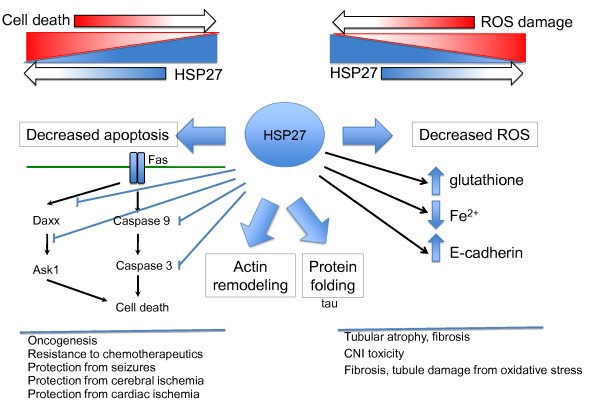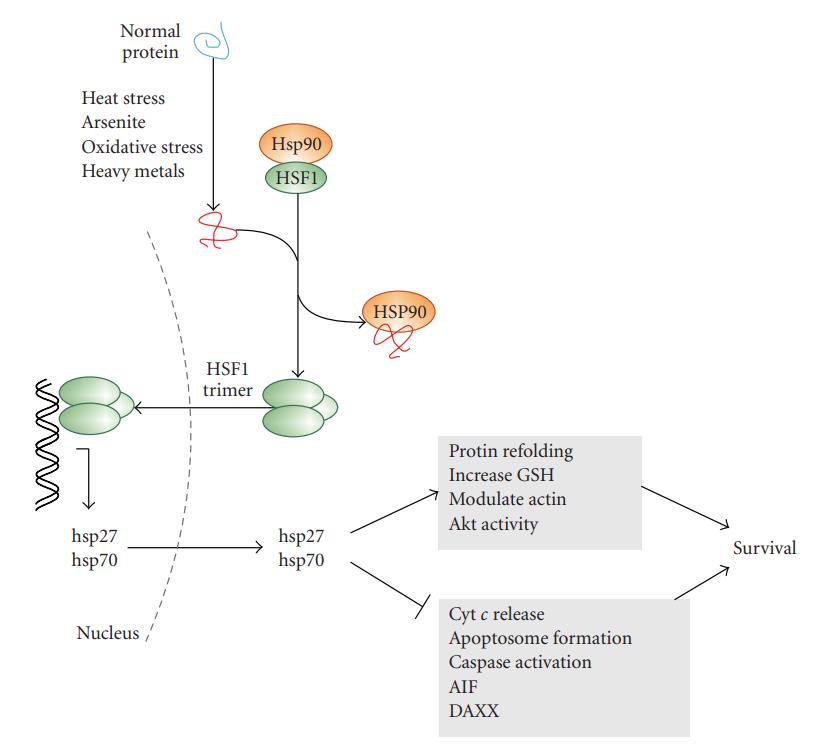Cellular Stress Assessment Service
Creative Biolabs has built several in vitro cell-based screening models to offer cellular stress assessment services in ADME. Cellular stress assessment is important for ADME Screening, and Creative Biolabs is committed to providing you with the highest quality of service.
HSP27 in Cellular Stress
The role of HSP27 (heat shock protein 27) as a biomarker is to reflect the progression and severity of various diseases such as renal injury and fibrosis, cancer, neurodegenerative diseases, and cardiovascular diseases. Changes in the expression levels of HSP27 can provide valuable information for diagnosing, evaluating disease progression, guiding treatment strategies, and monitoring therapeutic efficacy. Therefore, HSP27 as a biomarker helps in understanding the pathophysiological processes of diseases, aiding in treatment decisions, and assessing disease outcomes.
In cellular stress conditions, HSP27 plays a crucial protective role. It assists in the proper refolding of damaged proteins when cells are exposed to stress such as heat shock. Under oxidative stress, HSP27 acts as an antioxidant by reducing the levels of reactive oxygen species in the cell through increasing intracellular glutathione levels and decreasing intracellular iron levels. Moreover, in situations of chemical stress, HSP27 acts as an anti-apoptotic factor by engaging with pathways of apoptosis that are both mitochondrial-dependent and independent, thus inhibiting cellular demise. Furthermore, HSP27 is involved in regulating the dynamics of the actin cytoskeleton, promoting actin polymerization, and acting as an actin-capping protein.
 Fig.1 Overview of HSP27.1
Fig.1 Overview of HSP27.1
Cellular Stress Assessment
Cellular stress is the reaction of cells to different stressors, which can involve activating pathways that aid in cell survival or initiating programmed cell death to remove damaged cells. The nature and duration of the stress, along with the specific cell type, determine the cell's response. An appropriate stress response is essential for cell survival. Various stress types can elicit distinct responses, like the heat shock response or the unfolded protein response, to mitigate the stress and support cell survival.
 Fig.2 Heat shock proteins in cellular stress.2
Fig.2 Heat shock proteins in cellular stress.2
Based on measurements of HSP27 and other parameters in different cell models, Creative Biolabs provides you with comprehensive cellular stress assessment services. We evaluate the cellular stress potential of drugs by measuring morphological and biochemical parameters at the single-cell level in different cells. Our cellular stress assessment platform is designed to be precise, efficient, powerful, automated, and advanced.
Please see the information list below. Contact us at any time and we will provide you with the best service.
|
Cell model No.
|
1
|
2
|
3
|
4
|
5
|
|
Cell Type
|
Human primary hepatocytes (HPH)
|
Human dermal fibroblast cells (NHDF-neo)
|
Human renal proximal tubule epithelial cells (HRPTEpiC)
|
Human umbilical vein endothelial cells (HUVEC)
|
Human umbilical mesenchymal stem cells (HUMSC)
|
|
Measurement
|
Cell number;
HSP27
|
Cell number;
HSP27
|
Cell number;
HSP27;
KIM-1 (Kidney injury molecule)
|
Cell number;
HSP27
|
Cell number;
HSP27
|
Also, you might be interested in these ADME-related services: High-Throughput ADME, Analysis of Drug Metabolic Stability, and Analysis of Drug Distribution. Creative Biolabs is committed to providing you with efficient ADME services, and you will experience the future of technology with our state-of-the-art platform.
References
-
Vidyasagar, A., Wilson, N. A., & Djamali, A. "Heat shock protein 27 (HSP27): biomarker of disease and therapeutic target." Fibrogenesis & tissue repair 5.1 (2012): 7.
-
Fulda, S., et al. " Cellular stress responses: cell survival and cell death." International journal of cell biology (2010): 214074.
For Research Use Only | Not For Clinical Use


 Fig.1 Overview of HSP27.1
Fig.1 Overview of HSP27.1
 Fig.2 Heat shock proteins in cellular stress.2
Fig.2 Heat shock proteins in cellular stress.2
 Download our brochure
Download our brochure